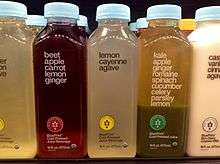Cold-pressed juice

Cold-pressed juice refers to juice that uses a hydraulic press to extract juice from fruit and vegetables, as opposed to other methods such as centrifugal or single auger.[1][2][3][4][5][6][7] The process of high pressure processing (HPP) allows the juice to be stored for about 30 days.[3][6][7] Without pasteurization or HPP, cold-pressed juices can be stored for 2 to 4 days. This type of juice has existed for decades, but gained public popularity in 2013 to the present day.[2][4] In general, these juices are more expensive than other types of juices.[1][2][4] It has been reported that a 16-ounce bottle could cost $10 or 12 ounces for $12.[2][4][6][6] Proponents of cold-pressed juice claim that this type of juice tastes fresher and contains more nutrients than pasteurized juices, though there is little evidence to support these ideas.[1][3][5]
History
Cold-pressed juices have been in production for several decades, but started to gain popularity in the late 2000s as a way to support juice cleanses.[2][4][5] Celebrities such as Gwyneth Paltrow and Kim Kardashian bolstered its popularity.[3][5] The initial use of cold-pressed juices for juice cleanses evolved into mainstream use, and the industry rapidly expanded in the early to mid 2010s.[3]
Manufacturing process
Making cold pressed juice is a 2 step process. Step 1 is to grind the fruit and vegetables into a pulp, and step 2 is to use a hydraulic juice press to squeeze the water out of the pulp, creating juice.
Industry
The rise of cold-pressed juice came at a time where the juice industry was stagnant.[6] Starting with Liquiteria in 1996, cold-pressed juice bars first emerged in New York City and have since spread internationally.[8] Though the size of the cold-pressed juice industry is not independently tracked, the sudden increase in popularity is undisputed, and 2013 estimates ranged from $1.6 billion to $3.4 billion.[5][6] Three major cold-pressed juice companies have been in direct competition: Suja, BluePrint, and Evolution Fresh.[5][6] Suja is the largest independent cold-pressed juice company, with a revenue of $18 million in 2013, the first year of its operation.[6][7] BluePrint was founded in 2007 and acquired by Hain Celestial Group in 2012 and had a revenue of $20 million in 2013.[5][6] Evolution Fresh was purchased by Starbucks in 2011 for $30 million.[6]
Hain Celestial Group, the owner of BluePrint, had a lawsuit filed against it in U.S. District Court for the Southern District of New York in October 2013.[6][9] The products were labeled as "100% Raw", "Raw and Organic", and "Unpasteurized", but the process of HPP destroys probiotics and enzymes.[6][9] However, the case was dismissed in July 2014.[10]
The popularity of cold-pressed juice has inspired social events related to the beverage. Juice Crawl, for example, is the world's first pub crawl for cold pressed juice. Participants in the event, held regularly in New York City, begin with a work-out, "pregame" with juice and travel to different juice bars.[11] Other popular brands are Pressed Juicery, Project Juice, Urban Remedy, Organic Avenue and Very Juice.
Health effects
Cold-pressed juices contain many beneficial nutrients, although by nature they are also high in very short carbohydrates like fructose, and low longer-chained carbohydrates like dietary fiber.[6] There is not enough research to determine if cold-pressed juices are healthier compared to pasteurized juices.[1][3][5]
It has been suggested that all high amounts of short acellular carbohydrates are detrimental to health.[12] Since juices by definition do not contain the pomace part of the fruit, and any cells in it have been destroyed, this makes any claims about higher amounts of nutrients questionable.
High cost
Cold-pressed juices could cost $2.99 for a 16-ounce bottle, and as high as $12 for a 12-ounce bottle.[2][4][6] The high cost has been attributed to the organic ingredients and the manufacturing process.[6] The manufacturing process is costly as an HPP machine could cost from $800,000 to over 2 million.[5] Alternatively, the incremental cost of toll processing could range from $0.25 – $0.45 per bottle, not including transport.[5] Juice companies say that consumers who juice at home with similar ingredients will pay a similar price.[6]
See also
References
- 1 2 3 4 Amidor, Toby (8 August 2014). "Cold-Pressed Juice: Is it Worth the Hype?". U.S. News & World Report LP. Retrieved 29 January 2015.
- 1 2 3 4 5 6 "Why Your Cold-Pressed Juice Is So Expensive". TheHuffingtonPost.com, Inc. 7 March 2014. Retrieved 29 January 2015.
- 1 2 3 4 5 6 Gordinier, Jeff (16 April 2013). "The Juice-Bar Brawl". The New York Times Company. Retrieved 29 January 2015.
- 1 2 3 4 5 6 Hallock, Betty (15 June 2013). "Cold-pressed juice, hot in L.A.". Los Angeles Times. Retrieved 29 January 2015.
- 1 2 3 4 5 6 7 8 9 10 Latif, Ray (12 September 2013). "The Juice Uprising". BevNET.com. Retrieved 30 January 2015.
- 1 2 3 4 5 6 7 8 9 10 11 12 13 14 15 16 Rosman, Katherine (11 November 2013). "What's Behind the Green Juice Fad?". The Wall Street Journal. Retrieved 30 January 2015.
- 1 2 3 Colao, J. J. (22 January 2014). "Suja Juice: The Unlikely Team That's Building The Country's Fastest Growing Beverage Company". Forbes. Retrieved 30 January 2015.
- ↑ "Fresh Fast Food Juice Beverages Offer Healthy Drink Options - QSR magazine". Qsrmagazine.com. Retrieved June 20, 2015.
- 1 2 Latif, Ray (28 October 2013). "Lawsuit Claims BluePrint Juices are Neither "Raw" Nor "Unpasteurized"". BevNET.com. Retrieved 30 January 2015.
- ↑ Klineman, Jeffrey; Rothman, Max (22 July 2014). "Calif. Judge Dismisses Hain Celestial Suit". BevNET.com. Retrieved 30 January 2015.
- ↑ "NYC Bladders Brace For City's First 'Juice Crawl'". Foodrepublic.com. Retrieved June 20, 2015.
- ↑ Comparison with ancestral diets suggests dense acellular carbohydrates promote an inflammatory microbiota, and may be the primary dietary cause of leptin resistance and obesity, Diabetes Metab Syndr Obes. 2012; 5: 175–189.